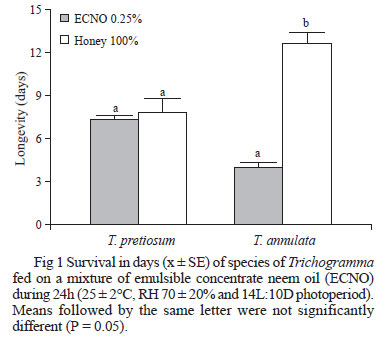Trichogramma pretiosum Riley and Trichogrammatoidea annulata De Santis are commonly found in avocado and persimmon orchards in northern Parana state. However, their abundance depends on whether insecticides are used or not to control the key lepidopteran pests Stenoma catenifer (Wals.) (Lepidoptera: Elachistidae) and Hypocala andremona (Stoll) (Lepidoptera: Noctuidae), respectively. The aim of this work was to evaluate the effects of an aqueous neem seed extract (ANSE) at 15, 3 and 1.5%, and of an emulsifiable concentrate neem oil (ECNO) at 2.5, 0.5 and 0.25% on lifetime parameters of these trichogrammatids as a way of testing the feasibility of integrating the biological and chemical control methods. Chemicals were applied on Anagasta kuehniella (Zeller) (Lepidoptera: Pyralidae) eggs before or after parasitization (one, three or five days). ANSE was more deleterious to both parasitoid species than ECNO, regardless of the concentration and the time of application. The chemicals acted on a concentration and time dependent manner. Treating the host with neem before parasitism was less deleterious to wasp emergence, especially for T. annulata. Pre-treatments (24h) of the host eggs with ECNO at concentrations varying from 0.5% to 0.25% did not affect T. pretiosum longevity, but 2.5% reduced T. annulata survival. Feeding wasps with honey mixed with 0.25% ECNO negatively affected T. annulata survival.
Botanical insecticide; Azadirachta indica; egg parasitoid






